How to fix a sewer leak - how to seal a pipe
Most apartment and house owners are gradually starting to switch to plastic pipes for sewer systems. Despite the increasing popularity of this material, cast iron pipes are also in demand, and it is not uncommon to see sewers made from these pipes in the house. If problems arise, it is necessary to start first of all from the material from which the pipe is made. How to fix a leak in sewer pipe, will be discussed in this article.
How to fix a leak in plastic sewer pipes
FROM pVC pipes everything is quite simple: it is enough to accurately localize the problem, and its further solution will immediately appear on the surface.
There are two areas in which a sewer pipe usually flows in a toilet or other place:
- One-piece pipeline section... If a section of a plastic pipe is damaged, the best solution would be to replace this section. Practice shows that the implementation of this method will give much better results than tightening the pipe with various clamps and gaskets. In addition, such a pipe repair is carried out extremely quickly, and the cost of the work is low.
- Pipeline joint... If a sewer pipe is flowing at the junction, then the cause of the leak in this case is usually damage or shift of the gasket, and it must, accordingly, be replaced or put in its place, for which the pipes will have to be disconnected. Those. in this case, sealing of the system is required (read: "Sealant for sewer pipes - how and how best to seal"). If the socket itself is damaged, due to which the sewer pipe joint is leaking, then the sewer leak can be eliminated by replacing this pipe section.
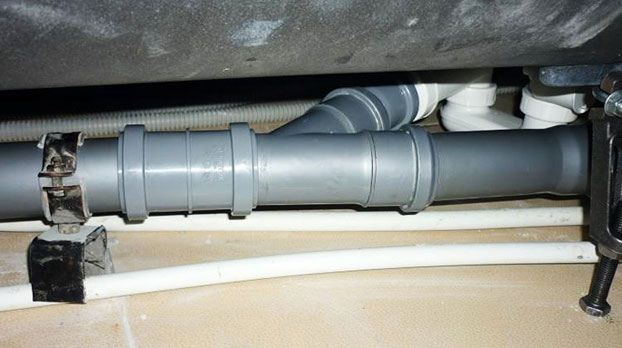
Plastic sewer pipes have a lot of positive qualities. Such products are ideal for installation, since they are quite lightweight and can be installed without problems. In addition, when installing plastic pipes, you can use sections of different lengths, since the couplings allow you to connect them completely without hindrance. If a sewer riser made of plastic is leaking, then the repair is quite easy.
If a cast iron sewer pipe is leaking
But before you fix the cast-iron sewer leak, you have to sweat. With pipes made of cast iron, everything is more complicated, and in the event of a leak, solving the problem can become difficult. The first step is to find the place of damage. In order for the search to be possible, the room must be cooled to 15-18 degrees - otherwise, condensation will necessarily appear on the pipes, preventing the location of the leak. When the problem is found, you can begin to solve it. Before fixing a sewer leak, you must first turn off the system.
Of course, the best solution lies on the surface: take the opportunity and replace all the cast-iron pipes in the house with plastic ones (read: "Replacing the cast-iron sewage system with a plastic one with your own hands"). If this option is not suitable, then it is necessary to repair the damaged area (in more detail: "Repair of cast-iron sewer pipes - methods and options"). How to repair a damaged pipe piece?
If the pipe is damaged in a straight section, the leak is eliminated using:
- a clamp with a rubber gasket, which can be purchased at a store or made by hand;
- a piece of cloth soaked in oil paint, varnish or epoxy glueby wrapping it around a leaking pipe;
- a fabric patch covered with a rubber strip and tied to the pipe with wire (read also: "Removing blockages in sewer pipes - do it yourself cleaning").

When cast-iron pipes are leaking at their junction, the repair is carried out as follows:
- the junction is well cleaned;
- the working surface must dry before repair;
- the cavity between the pipes is filled with sealant;
- when the sealant is completely dry, the drain can be used again.
If a leak occurs at the place where the plug is installed on the purge, the elimination of the problem will look like this:
- the plug (usually made of wood) is changed to a plastic one, and before installation it must be put in a rubber gasket;
- the plug can simply be changed to a new one by first wrapping it in several layers of polyethylene.
Elimination of sewer odor
If it was not possible to find a leak in the sewer pipe, and the smell of the sewage system still reaches the room, then the problem may lie in microcracks or leaking joints. Even if the pipe does not flow, and the sewer pipe joint does not flow, the best solution is still to completely replace the cast iron pipes with plastic ones.
To do this, follow these steps:
- first, the required number of plastic pipes is calculated;
- before starting work, the sewage system is turned off;
- now you need to reach the point of connection of the internal pipeline with the riser;
- the joint is cleaned to simplify further work: the old joint can cause a lot of trouble during dismantling;
- cast iron pipes are dismantled;
- a new pipe is connected to the riser (rubber gaskets can be used to fix it in place);
- then all other pipelines can be changed;
- the joint between the riser and internal sewerage treated with sealant to prevent leakage.
In this article, it was described in detail how to deal with a leaking sewer, and how to repair a leak in a sewer pipe. If done correctly and used suitable materials, then no problems will arise in the future.
http://kanalizaciyadoma.com
Any pipeline, wherever it is located, ages or gets damaged over time. In everyday life, the sewer pipe in the toilet most often flows. It constantly contains water, which gradually destroys the walls and connections of the collector. This problem also occurs for other reasons, the methods of elimination of which will be discussed in this article.
Signs of blockages
Sewerage is a complex system, the purpose of which is to remove waste water from residential or industrial premises. The volume of such effluent depends on the number of pollution sources. In modern apartments, in addition to a sink, toilet, shower stall, bath, there is other equipment (washing machine, dishwasher, etc.), It is also connected to sewer networkthat removes dirty water.
Sewerage is a complex branched system
On a note! A complex intricate system of pipes, consisting of numerous branches, is not immune to damage and breakdown. Moreover, an unexpected problem can arise at any section of the pipeline.
It is possible to understand that a sewer pipe made of cast iron or plastic needs urgent repairs by the following signs:
- The appearance of a characteristic unpleasant odor. It is felt in an area where a serious blockage in the pipe forms or it cracks.
- Leaks appear at the joints of the connected sections of the pipeline.
- The pipe does not allow water to pass through.
The latter case is not common at home, but sometimes this problem occurs. This clogs up the siphons under the kitchen sinks and the bathroom sinks. Debris accumulated in these nodes is removed without undue effort. Use a simple plumbing fixture for this - a plunger. Three or four confident sudden movements - and the mud plug will go down the drain. After that do not forget to rinse it big amount water.

First try to fix the problem with a plunger
Note! If the sink is equipped with a special opening to prevent overfilling (overflow), close it. Otherwise, the plunger will not fight the blockage, but drive air through the pipes.

Congestion most often occurs in siphons under sinks
If you don't know how to unclog a toilet drain, use a plunger too. Although this method does not always lead to a positive result, it is still worth trying. If the blockage cannot be removed, try using chemicals. If the result does not please you, you can break through the sewer using a special cable.
In the case of a complex blockage that cannot be removed by yourself, call emergency service... At professional plumbers special equipmentdesigned to eliminate serious sewer problems.
Sealing damaged joints
When the pipe is leaking at the inlet, excessive force is not required to repair the leak. You will need to do the following:
- Seal the existing entrance;
- Tighten the connection;
- Replace gaskets.
Most often, the owners are worried about the smooth operation of kitchen sinks, washbasins and bath drains. If the connection in the places where the siphon or drain hole passes into the pipe is not done carefully, then water seeps and drips in this place. Such problems are fixed on their own.
More laborious is the repair, which is caused by the destruction of the joints between the cast-iron elements of the sewage system. In this case, special knowledge and good physical training will be required. Depending on the material from which the pipe connection is made (cement or lead), the leak is eliminated in two ways.
With a cement joint
When the joint of the collector is sealed with cement mortar, the leakage of the sewer pipe in the toilet is eliminated as follows:
- break the old cement joint with a hammer or chisel, and then remove its fragments;
- thoroughly clean the joint from the remnants of the previous packing;
- put a cement mortar in the formed space and place a sealant in it (the cement mortar for packing is prepared at the rate of 1 part of water and 10 parts of cement);
- carefully and thoroughly seal the joint of the two sewer elements.
On a note! To make the seal better perform its function, plumbers process the strands with a special mixture. It includes seven parts of cement and three parts of asbestos. The components should be mixed thoroughly, and then water should be added to them. The result is a composition resembling plasticine in consistency.
With a lead plug
If lead was used to connect the junction of the sewer riser, then for the repair you will need to do the following:
- thoroughly clean the joint;
- place new lead cones in the gap, using a chisel as a tool. This procedure is not as laborious as it seems at first glance, because lead belongs to soft materials.
Sewerage repair
When a small gap appears in the cast-iron pipe, a chisel will help get rid of it. To do this, you should "hammer" the crack with the blunt end of the tool. When a small hole forms in the riser, it also does not take much time and effort to seal it. All that is needed is to drive a lead "plug" into it as described above.
From cast iron pipes
It is dangerous when a large piece falls out of the cast iron sewer pipe. What to do in this case?
- Cut out the damaged part of the structure using a special metal saw (grinder).
- Remove any hardened cement residues or pieces of lead packing.
- Make cross cuts in the remainder of the manifold. They are necessary to support the mount, which will loosen the pipe.
- Remove the loose structure from the stock. After that, you will need a rubber sleeve, which is sold at a building materials store.
Note! The inner cross-section of the coupling must coincide with the outer cross-section of the new pipe, which must be docked with the remaining part of the collector.
- Install the coupling using a seal to ensure the reliability of the joint.
- Apply cement mortar to the joint and paint over it after drying.
Such repairs are done without the involvement of professional plumbers. It's nice that in this case, along with the elimination of the leak, the family budget is rationally spent.
Made of plastic materials
Professionals do not recommend repairing damaged plastic piping elements. After completing such repairs, the level of reliability of the entire sewer network decreases, because intervention in at least one of the components of the collector violates the integrity and reduces the strength of the system.

If the plastic elements are damaged, it is better to replace them completely.
The correct solution in this case would be a complete replacement of the failed plastic pipe. The cost of purchasing a new riser will pay off by the fact that this replacement will not have negative consequences for the subsequent operation of the sewage system. On the contrary, it will be able to function without interruption for a long time.
On a note! Repair of plastic pipes involves the use of sealants. They temporarily seal the joints and places of smudges until the failed structure (cracked pipe) is replaced by a new one.
We hope the question of how to clean or repair the sewer pipe in the toilet does not cause you anxiety. You can deal with this problem yourself. Good luck!
It is necessary to solve the question of how to seal the leak in the sewer pipe with an accurate finding of the place of the leak and the reason, taking into account the pipe material.
Causes of accidents
Repair of sewer pipes takes place in emergency situations. There are different accidents, which means that they must be eliminated in different ways.
If a sewer pipe leaks due to mechanical damage, a major overhaul is inevitable: replacement of the entire pipe or part of it. If the connection is depressurized, minor repairs can be dispensed with.
Sewerage leaks, as a rule, due to damage to pipes or defects in their manufacture, as well as at the joints.
- Joint.
If the sewer pipe flows at the junction, you must:
- dry the joint;
- clean from clogging, cement or glue;
- close up the gap between the pipes with plumbing linen winding;
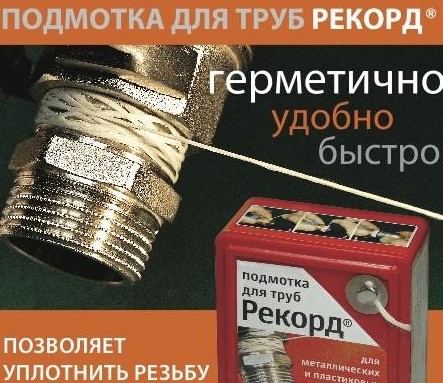
- generously cover with plumbing sealant;
- Do not use the sewer for 5 hours.

- Crack in the coating.
The problem of how to fix a leak in a sewer pipe if it goes through a cracked solution is solved as follows: after drying, we cover all cracks with silicone, epoxy, liquid rubber and even with plasticine.
- Fistula.
If water flows out through the fistula in the pipe, then you can temporarily drive in a short wooden wedge - a chop or a lead cone, then wrap the pipe with rubber or bandage and then soak it with epoxy, or make a clamp. Installing a clamp, even a homemade one, is the most reliable option.

Elimination of cracks
Shallow longitudinal cracks appear on the cast iron exhaust pipes due to temperature changes. We decide how to close up the sewer pipe separately in each case.
It is first necessary to slightly expand the outside, degrease and dry the crack, and then cover it with a sealant. Then you need to cover the pipe with a heat insulator.
Is the sewer pipe flowing through the cracks?
We eliminate radically:
- "Cold welding" with a special two-component adhesive;
- after hardening, we grind the seam and paint over it.
Fistula plugging
Method one


Method two



Tighten the coupling - the leak is closed
There are different plugs for sewer pipes.
- The plug is on the cleaning. If you do not use a cleaner, then you can cover the pipe joint and wedge with sanitary silicone.
To dry the joint, it is not recommended to use the sewage system for 2 hours. Can be dried with a hairdryer. If the chopik passes water, you can pull it out, preliminarily shaking it slightly, trimming it to insert it more tightly.
But before driving the chop in again, it is better to wrap it with plastic wrap from an ordinary bag.
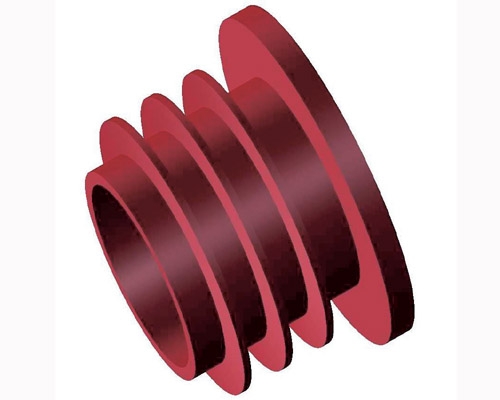
- Can be put in place of a wooden wedge plastic plug, and put a rubber gasket on the plug. How to cover the sewer pipe if it leaks again? It is necessary to glue the plug with a gasket with sanitary silicone.
- If there is a leak at the junction, the joint must be completely filled with gum arabic, that is, with liquid glass - office silicate glue, over the sealing.
Replacing the damaged area
Often, it is possible to eliminate a leak only by replacing the damaged piece of pipe with a whole one.
Necessary tools and parts: hacksaw for metal; linen; pipe wrenches; sealing putty; clutch; pipe cutter; union nut.
Progress
- We cut out a section of the pipe with a leakage + 30 cm with a hacksaw for metal.
- Unscrew the threaded connections, clean the thread, remove the cut piece.
- Let's cut the threads on the old pipe. To do this, hold it with a pipe wrench. This will prevent the pipe from deforming and turning.
- Screw the coupling onto the fixed pipe and find out the length of the replacement pipe, taking into account the thread length.
- Having fixed the pipe with a vise, we saw off the required section with a pipe cutter.
- Let's cut a thread on it with a klupp.
- After winding flax on the thread, seal it and lubricate it with a sealing putty.
- Connect the new segment with the old pipe with a pipe coupling.
- Use a union nut to connect the new pipe to the old pipe at the other end.
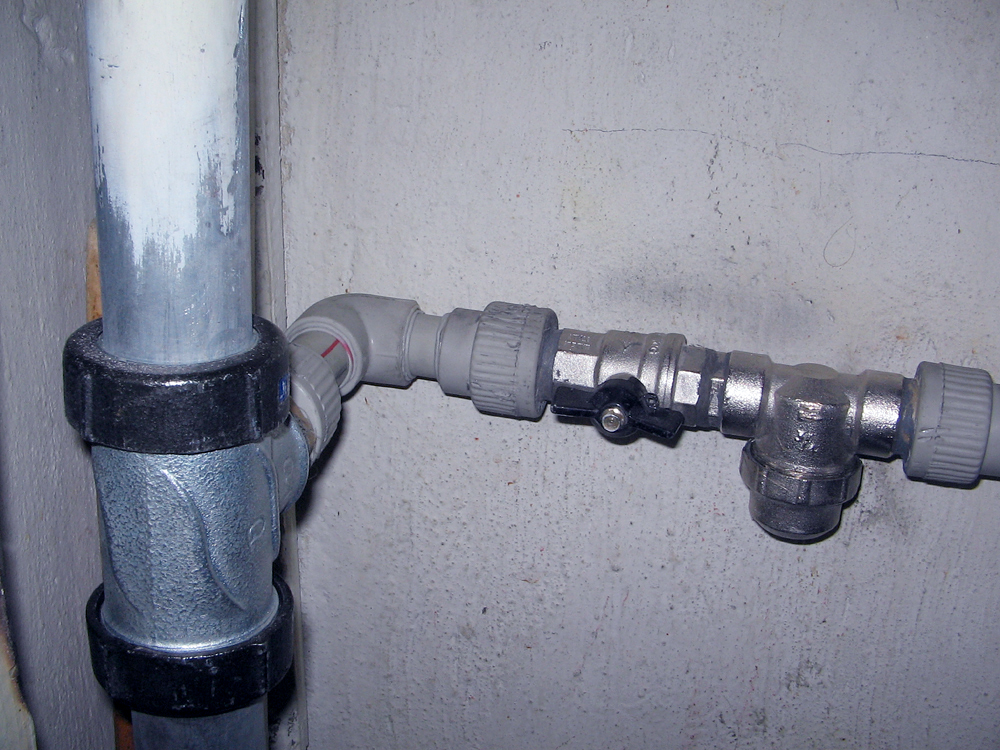
For emergency repairs, the tube can be wrapped with rubber from the bicycle tube and secured with couplings until overhaul.
Repair of cast iron pipes
We close the joints of cast iron pipes:
- winding strands;
- upsetting strands;
- putty with asbestos-cement mortar.
But first you need to clean the pipe to a clean metal.
If the service life of the sewer pipes has expired, the system must be dismantled:
- we cut the pipe with a grinder to the junction;
- we remove the remnants of packing, cement from the socket;
- on the remaining section of the pipe with a grinder, we make transverse cuts - an emphasis for the lever;
- insert the mount into the formed grooves and loosen along the pipe axis;
- we take the rest of the pipe out of the socket;
- put a rubber coupling-adapter into the socket;
- we put a plastic pipe in it.
Repair of plastic pipes
- If the surface of a plastic pipe is damaged, repair is not desirable due to its unreliability and low cost.
- The question of how to cover up a sewer pipe, its light damage is solved in a modern way simply: with a sealant.
- Additionally, fittings can be embedded. Tees are suitable for tapping into the sewer pipe (see details).
- If there is a leak at the joint, it is necessary to replace the deformed seals by lubricating the new ones with silicone.

If the sewer pipe is leaking (see also), you can easily and quickly eliminate the leak, using the indicated available means and self-confidence, or do it.
- damage to the element;
- factory defects of a tubular product;
- there is no sealing of joints.
Mechanical damage sewerage system fraught with major repairs - replacement of the entire pipe or part. In other cases, minor repairs are carried out.
If the reason why the pipes are leaking is a broken joint sealing, you should:
- Dry the joint thoroughly.
- Clean debris, blockages, old sealing substances (cement, glue).
- Choose how to glue the sewer pipe (the joint of the apartment's sewer pipe can be sealed with linen winding).
- Bathtub pipe sealing.
- The time for the element to dry is at least 5 hours (it is not recommended to use the sewage system for this time).
The reason why the sewage system is leaking is a crack in the coating. If it's all about a solution that is cracked, it is recommended:
- Dry the area where the pipe element is leaking.
- Choose how to cover up the damaged area (leaks can be eliminated with silicone, epoxy mortar, liquid rubber, plasticine).
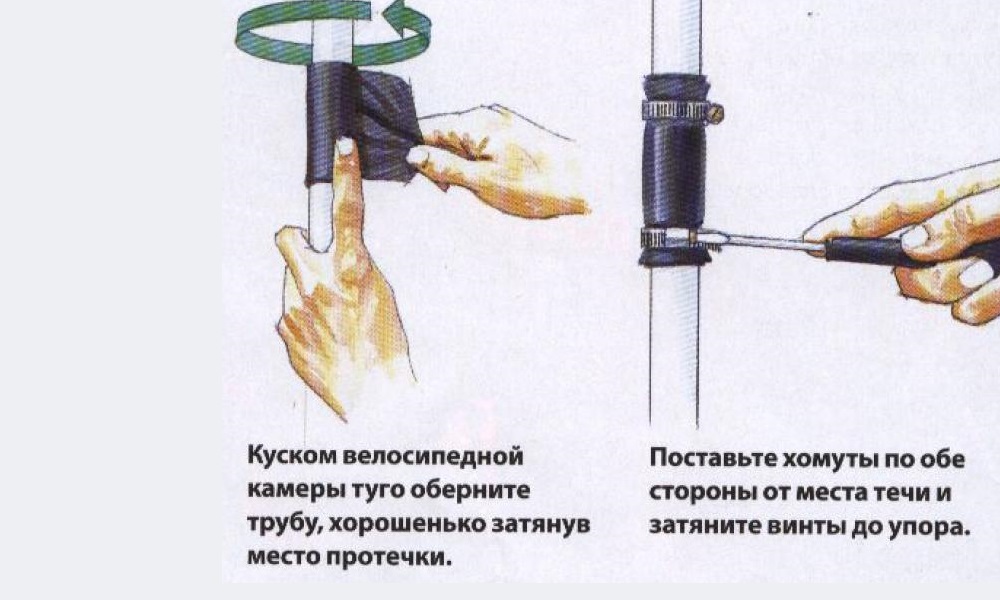
Before repairing a crack in a cast iron sewer pipe, you need a hair dryer. Shallow longitudinal cracks exposed cast iron pipe flow, most often occur against the background of frequent temperature changes. In such a situation, experts recommend degreasing and drying the crack with a construction hairdryer. The system can be sealed with a sealant. Then it is recommended to install the heat insulator.
Through cracks in the cast-iron sewer system are sealed with a special two-component glue ("cold welding" method). After hardening, the seam lends itself to grinding and painting. The joints of cast iron elements are processed using:
- spun windings;
- strand sediment;
- use of asbestos cement and its solutions.
Step by step execution of work
Damage cast iron products on a straight segment is fraught with the emergence of a strong flow. It is recommended to eliminate the leak in the sewer pipe only after cleaning the element to metal using:
- Rubberized clamp (factory or homemade).
- A piece of fabric impregnated with varnish or epoxy glue.
- Cloth patches that are closed with a rubber strip and tied with a wire to the pipe.
Before eliminating the leakage of the sewer pipe, you will need to dismantle:
- Cutting the pipe unit with a grinder to the joint.
- Cleaning the socket from packing, cement, glue.
- Create a stop for the lever with a grinder on the rest of the pipe.
- Installation of an adapter sleeve into the socket.
- Installing a new pipe in the adapter sleeve and fixing it.

If the pipe is leaking due to a fistula, then the system must be repaired with a small wooden chopik or a lead cone. The sewer pipe is wrapped with rubber, bandage; impregnated with epoxy or a clamp is used.
If the system was not cleaned, then the hole is sealed with sanitary silicone. It can be used to seal the pipe joint and wedge. It will take 2-3 hours for the joint to dry. You can use a hair dryer to speed up this process. Before hammering, the chopik is wrapped with polyethylene from a regular bag. For tight installation, it is processed with a plane.
Chopik material can be not only wooden, but also plastic. A rubber gasket is put on such a plug. For reliability, it is glued to the gasket with sanitary silicone. The current element of the sewer system can be sealed with gum arabic - liquid glass or office silicate glue. With its help, the pipe joint is also processed.
Additional work
Mechanical damage to the elements of the sewer system is eliminated by replacing the damaged area with a whole one. To do this, you will need the following tools: a hacksaw for metal, flax, pipe wrenches, sealant, coupling, pipe cutter, union nut.
Repair work step by step:
- Preparing a new element (must have a leak of + 30 cm).
- Unscrewing, removing the cut piece.
- Threading an old pipe.
- Screwing the coupling onto the stationary pipe.
- Threading a new product.
- Sealing threads with linen and putty.
- Connection of a new piece of a product with an old one using a pipe coupling and a union nut.
Urgent pipe repair can be done with rubber from the bicycle tube and coupling.
This will protect against sewage leaks before major repairs. If damaged plastic pipe, then it will not be repaired. It is being replaced by a new analogue.
Light damage to the plastic is covered with a hermetic agent. For additional reliability, fittings are cut in, tees are suitable. All deformed seals at the junction are replaced with new analogues, having previously lubricated them with silicone. With the help of the above recommendations, you can easily and quickly eliminate the sewage leak in the apartment before the arrival of the plumber.



